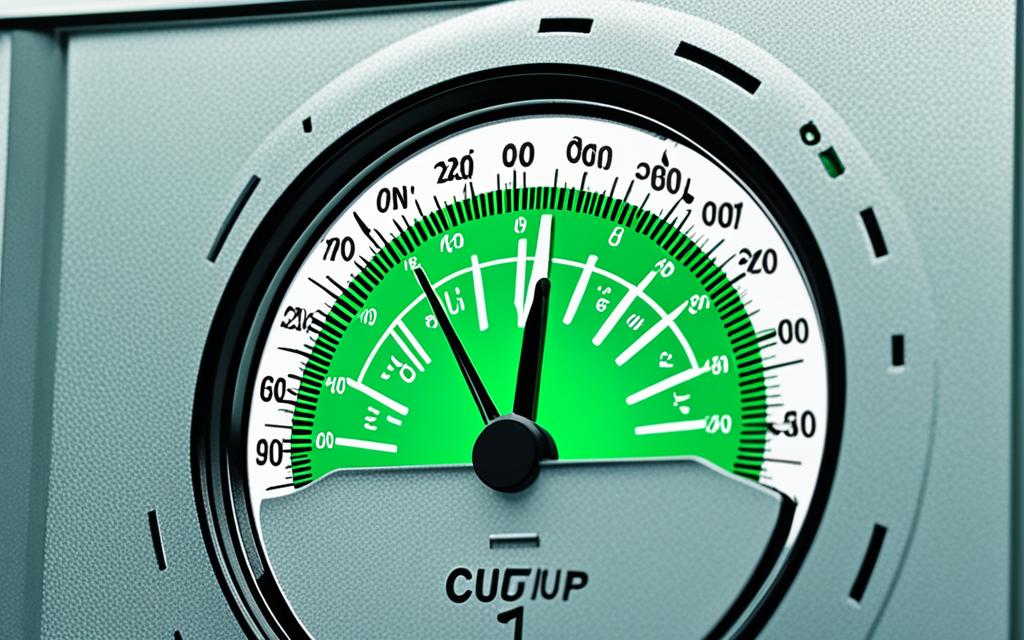Table of Contents
The central processing unit, or CPU, is a key part of any computer. Knowing the best temperature for it helps it work well and last longer. Most CPUs can safely work between 40°C to 80°C (104°F to 176°F) if they’re busy. During intense tasks, they might get between 60°C to 90°C (140°F to 194°F). If the temperature goes over 80°C often, it could mean trouble, harming the CPU’s performance and parts1.
Laptops and mobile devices usually run hotter, sometimes near 100°C2. It’s important to keep the CPU’s temperature in check. This can make the CPU work better and keep your computer healthy. To do this, check the temperature often. Also, make sure your cooling systems work well and keep the computer clean from dust3.
Key Takeaways
- Most CPUs operate effectively within 40°C to 80°C under regular use.
- Persistent temperatures above 80°C can signal potential issues and degrade performance.
- Different CPU models possess varying tolerances for heat.
- Monitoring CPU temperatures regularly can save your hardware from damage.
- Proper cooling systems are crucial for maintaining optimal CPU temperatures.
- Laptops generally operate at higher temperatures than desktops.
Understanding CPU Temperature
CPU temperature tells us how healthy and efficient the processor is. Keeping an eye on these temperatures is key. They affect how well the computer works. Knowing what the numbers mean helps users stop damage from overheating.
What Does CPU Temperature Indicate?
Normally, CPUs work well at 40 to 70 degrees Celsius for everyday tasks. When not doing much, they should be cooler, between 30 to 40°C. While browsing the internet, they can warm up to 40 to 60°C.
Playing games can push the temperature to 60 to 85°C. Doing heavy tasks like video editing can make it jump to 70 to 95°C. It’s important to remember that going above 95°C can cause problems. The CPU may slow down to cool down if it gets too hot4.
Factors Affecting CPU Temperature
Many things can change how hot the CPU gets. Room temperature, how good the CPU cooler is, how much work the computer is doing, and how well air moves inside the case all play a part. Also, overclocking increases the CPU’s heat.
It’s vital to keep the air moving inside the computer. Blockages or poor airflow can make the CPU and GPU too hot. This could make the computer run hotter than it should5.
What is Normal Temp for CPU
Knowing the right temperatures for your CPU can help it last longer and work better. It’s important to check the temperature, especially when your computer is doing simple tasks or running powerful applications. This helps keep your system healthy.
Idle versus Load Conditions
When your CPU is not doing much, its temperature should be between 30°C to 40°C (86°F to 104°F). This means it’s working well without too much effort. But, when you’re doing something like gaming or using demanding software, the temperature can jump to between 70°C and 80°C (158°F to 176°F). Keeping an eye on these numbers is key. If they go above 80°C (176°F), your computer could get seriously damaged6.
Comparison by CPU Type
Different CPUs can handle different heat levels. For example, gaming CPUs in fancy desktops work fine up to 80°C. Normal CPUs, though, work best when cooler, usually between 40°C to 65°C (104°F to 149°F). Knowing your CPU’s heat limits helps you avoid overheating6.
Common Temperature Ranges for CPUs
It’s vital to know CPU temperature ranges to keep your PC running well. Keeping an eye on the temperature prevents overheating and damage. Let’s dive into the normal temperatures and what they mean for your CPU.
Typical Idle Temperatures
CPUs usually stay cool, between 30°C to 50°C (86°F to 122°F), when they’re not busy7. The ideal resting temperature is about 30°C to 40°C (86°F to 104°F)8. Checking these CPU idle temperatures regularly tells you if your PC is healthy.
Safe Operating Conditions Under Load
Under heavy use, like gaming, CPU temperatures can rise to 60°C to 80°C (140°F to 176°F). They may even reach 95°C (203°F) during intense tasks7. To keep things safe, try to stay below 85°C (185°F)8. For instance, the Intel Core i7-7700K works best between 50°C to 70°C8.
Risks of Operating Outside Normal Range
High CPU temperatures can cause problems, like thermal throttling. This happens when the CPU slows down to cool off. It’s important once temperatures pass 80°C (176°F), signalling possible harm7. Always check for sudden temperature changes to spot problems early, keeping your CPU in good shape.
How to Monitor CPU Temperature
Keeping an eye on CPU temperature is key to prevent overheating and ensure your computer runs smoothly. You can start by checking the temperature in the BIOS at startup. Although this is a solid start, it doesn’t offer continuous monitoring. Thus, using specialized software is advised for constant tracking.
Using BIOS for Temperature Checks
To get into the BIOS, press a key like Delete or F2 during the initial boot-up, depending on your motherboard’s make. Once you’re in, the BIOS menu should help you find the hardware monitor section. Here, you’ll see the CPU temperature. Yet, for minute-by-minute tracking, other methods are needed.
Recommended Software Tools
For a deeper look into your CPU’s heat levels, several tools are out there. Windows users often go for Core Temp for its easy use and comprehensive data, whereas Mac enthusiasts might prefer Fanny or pay $12 for iStat Menus. Installing these aids in watching over your CPU’s temperature. It keeps your system safe from the harm high heat can cause. Ensuring your system maintains its cool is crucial9.
Infrared Thermometer Method
An alternative is the infrared thermometer. It offers quick and accurate temperature checks without any software. This tactic shines in situations that push your CPU hard, like gaming or video editing. It’s vital for preventing temperatures from hitting over 85°C, which could harm the CPU10. Using these strategies to monitor your CPU’s temperature can help keep your computer reliable and efficient for years.
FAQ
What is the normal temperature range for a CPU?
CPUs generally stay between 30°C to 40°C (86°F to 104°F) when not doing much. When working hard, temperatures range from 60°C to 80°C (140°F to 176°F). It’s important to keep an eye on these temperatures for good performance and long life.
What does CPU temperature indicate?
The temperature of a CPU shows how hard it’s working and how well it’s being cooled. If it gets too hot, it means it’s working a lot or not cooling properly. That’s when you need to check it to stop it from slowing down.
What factors influence CPU temperature?
Many things make a CPU warmer or cooler. These include its design, how demanding the task is, and even the room’s temperature. How well air moves around inside and what kind of cooling system you have also make a big difference.
What is the difference between idle and load conditions for CPU temperature?
When a CPU isn’t doing much, its temperature is usually 30°C to 40°C (86°F to 104°F). During heavy tasks, it can heat up to 60°C to 70°C (140°F to 158°F), depending on its design and workload.
How does CPU type affect normal temperatures?
The kind of CPU you have changes how hot it gets when busy. Powerful gaming CPUs might reach up to 80°C (176°F). But more general-use CPUs work well at cooler temperatures. This keeps them safe and working efficiently.
What are typical CPU idle temperatures?
Normal idle temperatures for CPUs are between 30°C to 40°C (86°F to 104°F). Staying in this range helps keep the system healthy and running smoothly.
What are considered safe operating conditions under load?
For most CPUs, a safe temperature under heavy use is between 60°C to 80°C (140°F to 176°F). It’s important to not go above this to avoid slowing down or damaging the CPU.
What are the risks of operating outside the normal temperature range?
If a CPU gets too hot, it might slow down to cool off, a process called throttling. Really high temperatures can even damage the CPU.
How can I monitor CPU temperature effectively?
You can check CPU temperature in different ways. The BIOS shows it when the computer starts. For more detail, use software like HWMonitor and Core Temp. These tools give ongoing updates on how hot the CPU is.
What BIOS features assist in temperature checks?
The BIOS lets you see the CPU’s temperature right when the computer turns on. This helps you know if it’s running cool enough before doing more demanding work.
Which software tools are recommended for tracking CPU temperature?
For keeping an eye on CPU temperature, try using HWMonitor, Core Temp, or SpeedFan. These apps show current temperature stats to help you manage your system’s performance.
How does an infrared thermometer help in measuring CPU temperature?
Using an infrared thermometer, you can quickly find out how hot your CPU is without software. This is very handy for checking the temperature fast, especially if you’re trying to figure out a problem.
Source Links
- https://www.linkedin.com/advice/3/what-normal-optimal-ranges-cpu-temperature-different – What are the normal and optimal ranges of CPU temperature for different types of processors?
- https://community.spiceworks.com/t/what-is-a-normal-temperature-for-a-cpu-and-how-do-i-keep-it-low/948818 – What is a normal temperature for a CPU and how do I keep it low?
- https://www.noyafa.com/blogs/knowledge-base/good-cpu-temperature – What Is A Good CPU Temperature? A Guide to Keep Your Processor Cool
- https://computercity.com/hardware/processors/normal-cpu-temperatures – Normal CPU Temperatures: Guidelines for Safe & Optimal Performance – ComputerCity
- https://gadgetmates.com/normal-cpu-gpu-temperatures-for-your-pc – Normal CPU & GPU Temperatures For Your PC – GadgetMates
- https://www.avast.com/c-how-to-check-cpu-temperature – How to Check and Monitor Your CPU Temperature
- https://www.lolvvv.com/blog/normal-cpu-temp-while-gaming – What is a Normal CPU Temp While Gaming?
- https://www.practicallynetworked.com/what-is-a-normal-cpu-temp-while-gaming/ – What Is a Normal CPU Temp While Gaming? – Practically Networked
- https://www.pcmag.com/how-to/how-to-monitor-your-cpu-temperature – cpu temperature monitor
- https://www.pandasecurity.com/en/mediacenter/how-to-check-cpu-temp/ – How to Check Your CPU Temperature – Panda Security








